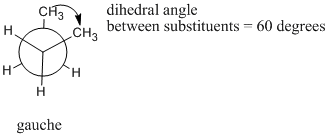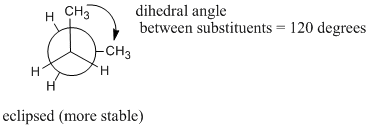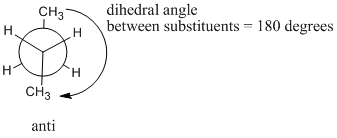CA3. Conformation of Butane
- Page ID
- 4042
CA3. Butane
In the case of ethane, conformational changes are very subtle, but in others they are more obvious. Butane (CH3CH2CH2CH3) has four tetrahedral carbons and three carbon-carbon bonds connecting them together. Let's number the carbons along the chain C1, C2, C3 and C4. Rotating around the C-C bonds connected to the terminal carbons -- C1-C2 and C3-C4 -- only subtle changes in shape would be apparent. However, rotating about C2-C3 produces some pretty obvious shape changes.
Pay attention to where the two methyl groups are with respect to each other. If we call C1-C2-C3-C4 the dihedral angle, then at 0 degrees the molecule is in an eclipsed conformation, apparent when looking at the Newman projection. Looked at from other vantage points, the molecule is curled up into the shape of a letter C.
Animation CA3.1. A three-dimensional model of butane. This C-shape that it adopts here is called the "least-stable eclipsed" conformation.
At 60 degrees, the molecule is no longer eclipsed, and just as in ethane the energy is a little bit lower, but the overall shape when viewed from the side is still a sort of twisted C.
Animation CA3.2. A three-dimensional model of butane. This shape is called the "gauche conformation".
At 120 degrees the molecule is eclipsed again , but from the side it has now twisted almost into a shape like the letter Z.
Animation CA3.3. A three-dimensional model of butane in the "most-stable eclipsed" conformation.
At 180 degrees, the molecule is staggered again and has settled into a regular, zig-zag, letter Z shape.
Animation CA3.4. A three-dimensional model of the "anti conformation" of butane.
These conformations of butane are really pretty different. Which shape would the molecule prefer? From what we learned about ethane, we could probably rule out the eclipsed conformations. Each of those would have 3 kcal/mol of torsional strain.
However, there is another factor that destabilizes the initial conformation at 0 degrees, in favour of the Z-shaped one with the methyl groups 180 degrees apart from each other. This factor is called "sterics" and it refers to the idea that molecules, or parts of molecules, take up space, and so two parts of the butane can't occupy the same place at the same time. Put more simply, sterics refers to crowdedness. When the two methyl groups in butane are too close together, they are too crowded, and they are at higher energy. When they get farther apart, crowding subsides and the energy in the molecule goes down.
- Torsional strain forces bonds on neighbouring carbons to be staggered.
- Steric strain forces groups away from each other to relieve crowding.
- Torsion and sterics both contribute to strain energy.
- Strain can be released by getting the molecule in a lower energy conformation.
For butane, that means getting those two methyl groups away from each other and keeping the bonds staggered.
There is some additional jargon that is used to describe these butane conformations:
- In an anti conformer, the largest groups are 1800 from each other.
- In a gauche conformer, the bonds are staggered but the largest groups are 600 from each other.
Problem CA3.1.
Draw Newman projections of the following compounds in a gauche and an anti conformation.
a) 1,2-dichloroethane (ClCH2CH2Cl) b) 1,2-butanediol (CH3CH2CH(OH)CH2OH)
c) 2-chloroethylamine (ClCH2CH2NH2)






